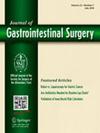胎盘生长因子(PlGF)作为生物标志物在可切除胃癌患者中的作用。
IF 2.2
3区 医学
Q3 GASTROENTEROLOGY & HEPATOLOGY
引用次数: 0
摘要
背景:系统性治疗失败和对新辅助治疗的治疗反应不足强调了对胃癌患者进行更好的肿瘤定向治疗的紧迫性。血管生成途径在这种癌症亚型中反复显示出预测和预后价值,然而,胎盘生长因子(PlGF)的相关性尚不清楚。因此,我们的目的是评估PlGF作为预后和预测性生物标志物。方法:本研究分为两个阶段进行。首先,用重组血管生成生长因子和化疗药物处理AGS和MKN-45胃细胞系。细胞计数分析和qPCR评估增殖和细胞毒性作用。其次,前瞻性采集胃癌手术患者的血液样本,采用ELISA法评估其与临床病理结果的相关性。结果:在MKN-45细胞中,用PlGF治疗可导致72h后细胞数量增加(p结论:PlGF表达升高与疾病特异性生存相关,但与其他肿瘤特异性预后因素无相关性,这可能表明PlGF可作为胃癌的独立预后生物标志物。正如细胞实验所证明的那样,预测对新辅助治疗的耐药性的能力需要在临床环境中进一步研究。本文章由计算机程序翻译,如有差异,请以英文原文为准。
The role of placental growth factor as a biomarker in patients with resectable gastric cancer
Background
Systemic treatment failure and an insufficient treatment response to neoadjuvant treatment underscore the urgency for better tumor-directed treatment for patients with resectable gastric cancer. The angiogenic pathway has repeatedly shown predictive and prognostic value in this cancer subtype; however, the relevance of placental growth factor (PlGF) is unclear. Therefore, we aimed to assess PlGF as a prognostic and predictive biomarker.
Methods
This translational study was performed in 2 phases. First, adenogastric (AGS) and Mie-Kinen-45 (MKN-45) gastric cancer cell lines were treated with recombinant angiogenic growth factors and chemotherapeutic agents. Cell count analyses and quantitative polymerase chain reaction were performed to assess proliferative and cytotoxic effects. Second, prospectively collected blood samples of patients undergoing surgical treatment for gastric cancer were assessed by enzyme-linked immunosorbent assay and correlated to clinicopathologic outcomes.
Results
In MKN-45 cells, treatment with PlGF led to increased cell numbers after 72 h (P <.01), whereas proliferative effects of PlGF were less pronounced in the AGS cell line. Addition of PlGF lowered the cytotoxic effect of standard chemotherapeutic agents as evidenced by significant differences in cell growth at low concentrations of cisplatin (5 µM cisplatin vs 5 µM cisplatin plus PlGF) and high concentrations of paclitaxel (25 µM paclitaxel vs 25 µM paclitaxel plus PlGF) in both AGS and MKN-45 cell cultures after 72 h (all comparisons P <.05). In patients with gastric cancer (n = 68), high PlGF concentrations were significantly associated with more recurrences (estimated 5-year-recurrence rate, 34% [high PlGF] vs 6% [low PlGF]; log-rank P =.009) but no association was found with pathologic treatment response, tumor size, nodal stage, or tumor grade.
Conclusion
The association of elevated PlGF expression with disease-specific survival despite no correlation with other tumor-specific prognostic factors may indicate that PlGF could be used as an independent prognostic biomarker in gastric cancer. The ability to predict resistance to neoadjuvant treatment, as demonstrated in cell experiments, requires further investigation in a clinical setting.
求助全文
通过发布文献求助,成功后即可免费获取论文全文。
去求助
来源期刊
CiteScore
5.50
自引率
3.10%
发文量
319
审稿时长
2 months
期刊介绍:
The Journal of Gastrointestinal Surgery is a scholarly, peer-reviewed journal that updates the surgeon on the latest developments in gastrointestinal surgery. The journal includes original articles on surgery of the digestive tract; gastrointestinal images; "How I Do It" articles, subject reviews, book reports, editorial columns, the SSAT Presidential Address, articles by a guest orator, symposia, letters, results of conferences and more. This is the official publication of the Society for Surgery of the Alimentary Tract. The journal functions as an outstanding forum for continuing education in surgery and diseases of the gastrointestinal tract.

 求助内容:
求助内容: 应助结果提醒方式:
应助结果提醒方式:


